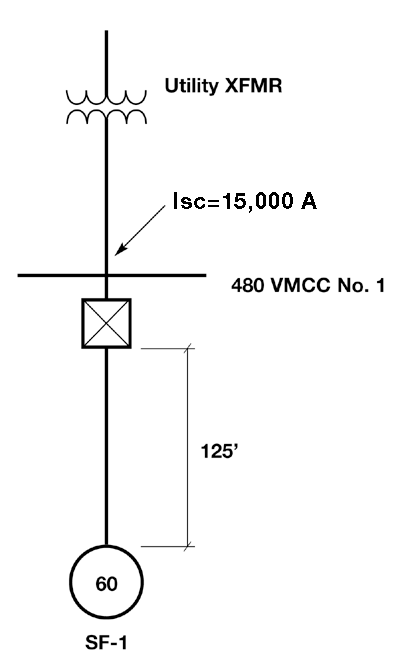Project No.: 1234-5678-01
Calculation Number: E-01
Sheet No. 1 of 2
By: TJC
Date: 4/24/02
Checked:
Date:
Objective
Determine whether SF-1, a 60 hp, 1,800 rpm, 460-V fan motor can be started using an across-the-line starter without causing unacceptable voltage drop.
2. MCC voltage during start >=0.95 x 480V = 456V
Note: 95% selected vs. 90% to allow for 5% low utility voltage during peak periods.
Background
Motor is NEMA standard Design B, requiring a minimum of 90% rated voltage at the terminals for starting. MCC is served directly by utility at 480V with three-phase short circuit current = 15,000 A RMS SYM. Motor feeder is 125 ft, sized per NEC.
Feeder will be sized for FLA per NEC. Feeder impedance and source impedance will be converted to ohmic quantities. Voltage at MCC and motor during start will be calculated from product of locked-rotor current and circuit impedance. To simplify calculation, total voltage drop to motor = algebraic sum of voltage drop in service plus voltage drop in feeder will be used, rather than vector sum (conservative).
References
1. Utility short circuit current: Letter from XYZ Public Service Co., dated 1/1/01 (copy attached).2. NEC, Article 430 and Table 310-16 for conductor sizing, Table 9 for conductor properties.
Assumptions and Data
1. Motor FLA per NEC Table 430-150 = 77 A.2. Motor LRA = 6 x FLA = 462 A.
3. Motor starting power factor (PF) = 0.20.
4. Feeder is in steel conduit vs. plastic (conservative).
5. Utility impedance is purely reactive (R=0).
Computation
A. Size motor feeder:Req'd ampactiy = 125% of FLA; 1.25 x 77 A = 96.25 A
Using 75 C ratings in Table 310-6, select #3 AWG Cu. With ampacity = 100 A
B. Compute motor feeder impedance and voltage drop:
From NEC, Table 9, for #3 AWG Cu. In steel conduit, R = 0.25 O/1000', X = 0.059 O/1000'
Using Zeffective = Rcos (T) + Xsin (T), where T = cos-1(PF); and using Vdrop = ILRAZeffective (footnote to Table 9),
T = cos -1(0.20) = 78 degrees. Zeffective = (0.25 O/1000')cos(78 degrees)+(0.059 O/1000')sin(78 degrees) = 0.109 O/1000'
Vdrop = 125'/1000')(0.109 O/1000')(462 A) =6.29 V
Note: Due to the program's limitations, Greek letters aren't shown on this calculation sheet. Consequently, the bold "O" represents an uppercase Omega, and the bold "T" represents a lowercase Theta. Engineered Systems regrets the inconvenience.
C. Compute utility impedance and voltage drop:
Using Z=V/lSC, Zutility = 277 V/ 15,000 A = 0.018 O
Vdrop = lLRAZ= (462 A)(0.018 O) = 8.32 V
D. Compute MCC bus voltage:
VMCC = 1.73(VL-N - Vdrop) = 1.73 (277 V - 8.32V) = 464V
E. Compute motor terminal voltage:
V motor = 1.73 [(VMCC/1.73) - Vdrop)] = 1.73[(464 V/1.73) - 6.29 V)] = 453V
